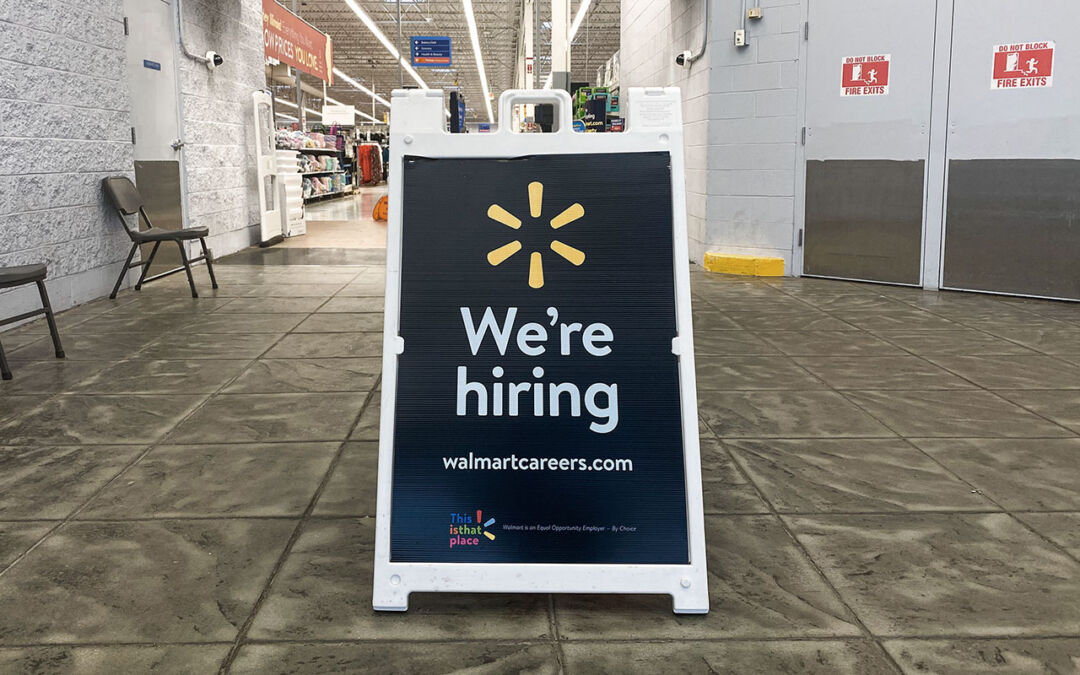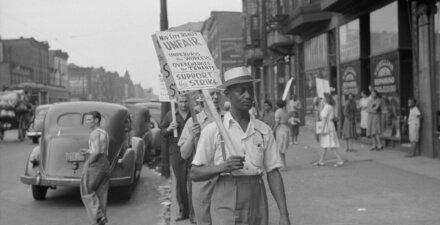How a large employer’s low-road practices harm local labor markets: The impact of Walmart Supercenters

Large employers in the United States can have significant impacts on the local labor markets in which they operate, not only affecting their employees directly but also spilling over to other workers living and laboring nearby. Recent research by Ellora Derenoncourt of Princeton University and Clemens Noelke and David Weil of Brandeis University, for example, finds that voluntary minimum wage increases among large employers, such as Amazon.com Inc. and Target Corp., spilled over and led to wage increases for other workers in the same commuting zone.
Yet a new Equitable Growth working paper by grantee Justin Wiltshire of University of California, Davis finds the converse is also true. He finds that the expansion of a particular “low-road” employer—Walmart Inc.—offering low wages leads to a negative spillover in wages and decreased employment in a local labor market. This new evidence features clever empirical analysis of the opening of Walmart Supercenters around the country, compared to locations where a Supercenter was proposed but blocked, adding to a growing body of evidence on the prevalence of monopsony dynamics across the U.S. labor market suppressing wages and limiting employment.
Walmart has long been the largest private-sector employer in the United States. According to the new analysis by Wiltshire, the expansion of Walmart—and, in particular, the opening of Walmart Supercenters—accounted for half of retail employment growth since their beginning in the late 1980s, accounting for 2.5 percent of all employment growth in this time period.
Walmart also is notable for remaining a low-road employer—not following the lead of other retail giants in establishing a higher minimum wage. With low wages and poor job quality, Walmart faces an estimated employee turnover rate of 70 percent per year. Walmart’s demand for labor to match their high turnover rates, paired with its persistent low wages, indicates that Supercenters may be monopsonistic employers that set wages below the rates that would exist in a more competitive labor market.
While it’s intuitive that a large low-road employer such as Walmart may negatively impact local labor markets, previous research found mixed evidence due to methodological limitations in the research and what is known as endogeneity biases. Endogeneity biases occur when examining the impact of, say, a Walmart opening in a particular location makes it difficult to delineate between the impact of that Walmart itself and whether Walmart’s expansion was itself impacted by local conditions ripe for the expansion of a big box store and low-road employer.
Wiltshire seeks to overcome this bias in his new working paper. Using an illuminating empirical design, he is able to better test the direct impact of a Walmart expansion by constructing a so-called stacked-in-event-time synthetic control estimator of locations, economic parlance for identifying the counties where a Walmart Supercenter was proposed and blocked—making up the “donor pool” in the “synthetic control”—compared to those locations where a Supercenter was successfully opened. The group of counties with a proposed, but not realized, Supercenter presumably have similar attributes to counties in which a Supercenter was opened.
To conduct the empirical study, Wiltshire uses data from the Quarterly Census of Employment and Wages from the U.S. Bureau of Labor Statistics for county-level labor market outcomes, Dunbar Market Indicators data for Walmart locations and its employment and sales, and Tax Policy Center data on minimum wages. Using these data sources, Wiltshire finds that the entrance of a Walmart Supercenter increases retail employment by 2.2 percent in a county during the year of entry and by 1.4 percent by the fifth year.
Yet a Supercenter entrance into a county also reduces aggregate employment levels by 2.9 percent and reduces labor force participation by 1.4 percent by the fifth year. Furthermore, the simultaneous retail employment growth with aggregate county employment decline means that the Supercenter increased employment concentration in a county over time. Retail earnings increase by 1.5 percent at the time of Supercenter entry then fall back to pre-entry levels, while county level earnings decline by 5.2 percent by 5 years after entry.
Because earnings decline for both goods-producing and service-providing industries, Wiltshire hypothesizes that perhaps wages in goods-producing industries are impacted by monopsony buyer power vis-à-vis suppliers. In short, labor market conditions got worse, with fewer people working and lower average wages in the years following the opening of a Walmart Supercenter, compared to other, similar counties that were successfully able to block expansion.
One implication of monopsony is that increases to the minimum wage or wage increases driven by collective bargaining among monopsonistic employers can lead to a simultaneous increase in earnings and employment levels at employers operating in monopsonistic labor markets. This can be the case because noncompetitive labor markets are operating under capacity with deadweight loss, defined as the inefficient allocation of resources since the economy is underproducing and undercutting the wages of workers.
Wiltshire continues his analysis by examining the impact of the 1996–1997 federal minimum wage increase on counties that already had a Walmart Supercenter. Five years after the minimum wage increase, Supercenter counties experienced increases in both retail and aggregate employment of roughly 5 percent, alongside an increase of 5 percent to 8 percent in aggregate earnings and 4 percent to 5 percent in retail earnings. These results are consistent with Walmart exercising monopsony power in these counties and the ability of labor market policy to reduce the monopsony power of employers to keep wages lower than market rates.
This study of Walmart clearly quantifies the negative impact of monopsony for workers and the local economies where they work. While previous research on monopsony has found more evidence of monopsonistic wage-setting pressure for relatively high-wage workers who are more likely to be specialized and have fewer outside options, such as registered nurses in the highly consolidated healthcare industry, large dominant low-road employers in local labor markets are a case in which monopsony also impacts low-wage workers.
In these instances, policy tools such as increasing the minimum wage are good for workers and good for the entire economy, with the ability to increase earnings and employment in a win-win. Furthermore, improving income supports for low-wage workers may improve their mobility out of poor-quality jobs. And in a monopsonistic labor market, ensuring that workers have the ability to exercise voice and bargain for higher wages is a critical tool in balancing employer wage-setting power that has plagued the labor market—which, in turn, will lead toward broadly-shared growth.





